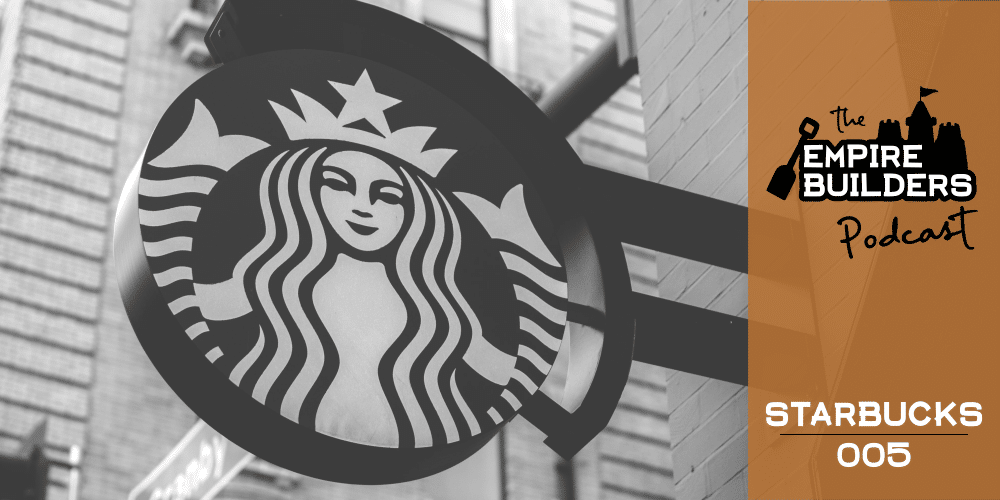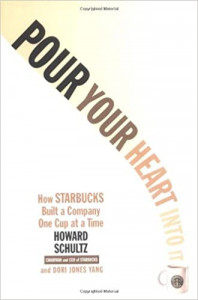
Subscribe: Apple Podcasts | Google Podcasts | Amazon Music | Blubrry | RSS | More
How a sip of espresso at a piazza in Italy transformed the coffee industry in North America. It seems obvious now. But trust me. This idea was crazy. Learn just how crazy it was. You may need to go to Italy for inspiration.
David Young:
Stephen, my notes say Starbucks today. Now, I don’t know. Are we heading to Starbucks? We’re going to do the drive-through? I’ve got credit on my Starbucks card. What do you want?
Stephen Semple:
Five buck lattes, here we come.
David Young:
All right.
Stephen Semple:
We’re going to go back to the early days of Starbucks because one of the problems is Starbucks’ business seems obvious today. But I’m going to tell you, if Howard Schultz back in the early days, came into your office pitching you to invest in Starbucks, you’d probably tell him to get the hell out of your office. Starbucks was founded in ’71 and Howard Schultz bought it in 1980. At that time, I’m not sure whether it was four or six stores, but it was just a couple of stores in the Seattle area. Today, they have over 30,000 locations. They’re doing $25 billion in revenue. They are everywhere, right? And in fact, they’ve had such an impact on the coffee business it’s even changed McDonald’s. McDonald’s created the McCafes in response to what’s going on with Starbucks.
 But let’s go back to the early days because one of the things we’re often talking about in the Empire Builders Podcast is how you’ve got to do things that are bold and different if you want to build an empire. Copying everybody else? Fine, you can get a little bit of growth, but you aren’t going to change the world. You aren’t going to change your industry and you aren’t going to become a billion-dollar business doing that. So let’s go back to the early days of Starbucks. And if you want to learn more about the Starbucks story, I recommend reading the book, Pour Your Heart Into It, which is written by Howard Schultz. It’s a fascinating story about this business. But here’s the thing, if we go back into the late ’70s, early ’80s, the belief in the coffee business was coffee sales were declining overall, believe it or not. Just look at a Starbucks today and look at how many young people are in it.
But let’s go back to the early days because one of the things we’re often talking about in the Empire Builders Podcast is how you’ve got to do things that are bold and different if you want to build an empire. Copying everybody else? Fine, you can get a little bit of growth, but you aren’t going to change the world. You aren’t going to change your industry and you aren’t going to become a billion-dollar business doing that. So let’s go back to the early days of Starbucks. And if you want to learn more about the Starbucks story, I recommend reading the book, Pour Your Heart Into It, which is written by Howard Schultz. It’s a fascinating story about this business. But here’s the thing, if we go back into the late ’70s, early ’80s, the belief in the coffee business was coffee sales were declining overall, believe it or not. Just look at a Starbucks today and look at how many young people are in it.
The demographics for coffee back then were old people, which were dying off. The coffee business was dying with its consumer. Coffee prices were declining. A cup of Joe is what coffee was and it was drunk in diners with those linoleum counters and people smoking and the tacky, you remember the tacky little metal trim that was screwed in and some surly waitress. They were located in Seattle and the Seattle economy was poor, it was abysmal. Boeing, the largest employer was struggling and laying people off right, left, and center. Schultz was in the coffee business and he had just returned from a trip to Italy where he experienced Italian coffee and cafes. And he said this seems like a good idea for the United States. What I’m going to do is I’m going to charge a premium price for coffee. Remember, coffee prices are declining, the local economy’s the shits, your consumers dying off, are and I’m going to charge a premium price for my coffee. And I believe the reason why coffee is dying is because we have a crappy product and a terrible experience. And I’m going to change that. I’m going to charge $5. Prices are declining, the economy’s crap…
David Young:
The price of a full meal.
Stephen Semple:
Right. You would have kicked that guy out of your office. You would have said, there’s the door Howard, I love you, but you’re a moron, you’re crazy, you’re deranged. And today, the coffee business has completely changed. They revolutionized that entire business and they made billions of dollars in the process. And by the way, if you’re interested, Schultz left and he’s back, sounds kind of similar, right? Apple, Jobs left and then he’s back. If you’re interested, go to YouTube and see what they’re doing with their premium stores in Chicago and places like that. It’s like Willy Wonka designed a coffee store. They are incredible. They are going to change the coffee business again. But that’s a story for another time. The thing that’s interesting, the lesson on this is, if you looked at Starbucks today, it doesn’t look revolutionary. They became big because what they did was revolutionary and they believed in it and they looked beyond the data. The data would say don’t do it. Coffee drinkers are dying off. The price is falling. Don’t do it. The data says don’t do it.
He did one of the things we talk about learning. Bring an idea from somewhere else and apply it. He saw this in Italy and he said, this would work in the United States. Now it’d be really easy to dismiss that and go, well, that’s Italy, that’s not the United States. That’s that, that’s not this. Our greatest learning comes from looking at other industries, other geographies, other things, and pulling those things into our world. But, of course, everybody will dismiss it by saying, well that’s Italy. That’ll never work in the United States.
David Young:
Do you think he came across that idea of the third place while he was in Italy? That it wasn’t just about the coffee?
Stephen Semple:
Absolutely, when you read his book, it’s very, very much about the third place. The relationship with the barista, a nice place to sit and have a cup of coffee. Yes. That is as important, if not more important than the coffee itself.
David Young:
It’s having that place. When you talk about how we can’t see the coffee business without seeing Starbucks today, because of that. If you ask somebody to go grab a cup of coffee, odds are unless there’s some really popular local Starbucks knockoff, it’s going to be “Which Starbucks are we meeting at?”
Stephen Semple:
And even the knockoffs are not the diners. They are cafes that have tried to also do something interesting, whether it’s their own take on coffee or the décor, or like there’s one near me where you’ve got to walk down this little alleyway and it’s hidden at the back of the alleyway. You go in and it’s got these big rafters and skylights and all this other stuff. Look, Starbucks’ influence is so great, especially when you talk about place, it now defines place. It’s a well-documented fact that if a Starbucks opens in your neighborhood, real estate prices go up. So, to your point of place is if I see that there’s a Starbucks, I automatically assume it’s a desirable neighborhood and I want to live there.
David Young:
So, what’s the lesson here for a small business owner, that you can apply universally?
Stephen Semple:
It’s two things. One is this whole idea that you’ve got to be bold. Part of knowing you’re onto the right idea is if everybody thinks you’re a little crazy, right? And that’s the reason why I like to word it as bold, not big. It’s about being bold. Where people are like, “Wow, I don’t know that’s Italy and it’s not the United States. That won’t work here.” When you hear those things, it still might be a poor idea, but you’re possibly on the right track. If you don’t hear those things, question yourself. So that’s one lesson.
But the other is, we need to continually be looking outside of our box. The problem is that when we look for success, if you’re a jeweler, the common thing to do is, “Let me look at what all the other jewelers are doing?” Or, “What are all the builders doing?” Or even worse yet, “What are the retailers in my neighborhood doing?”
We need to look outside. You don’t learn from your industry. You learn from other industries and figure out how to apply it. You learn from other geographies and figure out how to apply it. And don’t get caught in the trap of thinking that won’t work, that only works for this. Figure out how to make these other ideas work. And they do. We’ll have other examples going forward of businesses that took an idea from somewhere else and brought it and applied it on something that kind of looked a little crazy at the time that now that they’re these big monsters, it doesn’t look crazy. But, back in 1980, it was a little nuts.
David Young:
A little nuts. So, when people call you crazy, it might just be, you’re on the right track.
Stephen Semple:
Yeah. Exactly.
David Young:
Don’t be afraid of that.
Stephen Semple:
To your point on place, the story Howard Schultz tells about place in terms of being in Italy, and how he applied that to Starbucks, is so fascinating and so well told that you really want to read it for yourself and pour your heart into it.
David Young:
Thanks for listening to the podcast. Please share us. Subscribe on your favorite podcast app and leave us a big fat juicy five-star rating and review at apple podcasts. And if you’d like to schedule your own 90 minute Empire Building session, you can do it at empirebuildingprogram.com
- Tapping Into the Zeitgeist: Monopoly’s Origin Story - December 17, 2025
- From Mars Men Mediocrity to Sour Patch Success - December 10, 2025
- The Hidden Psychology Behind Cabela’s Success - November 28, 2025
